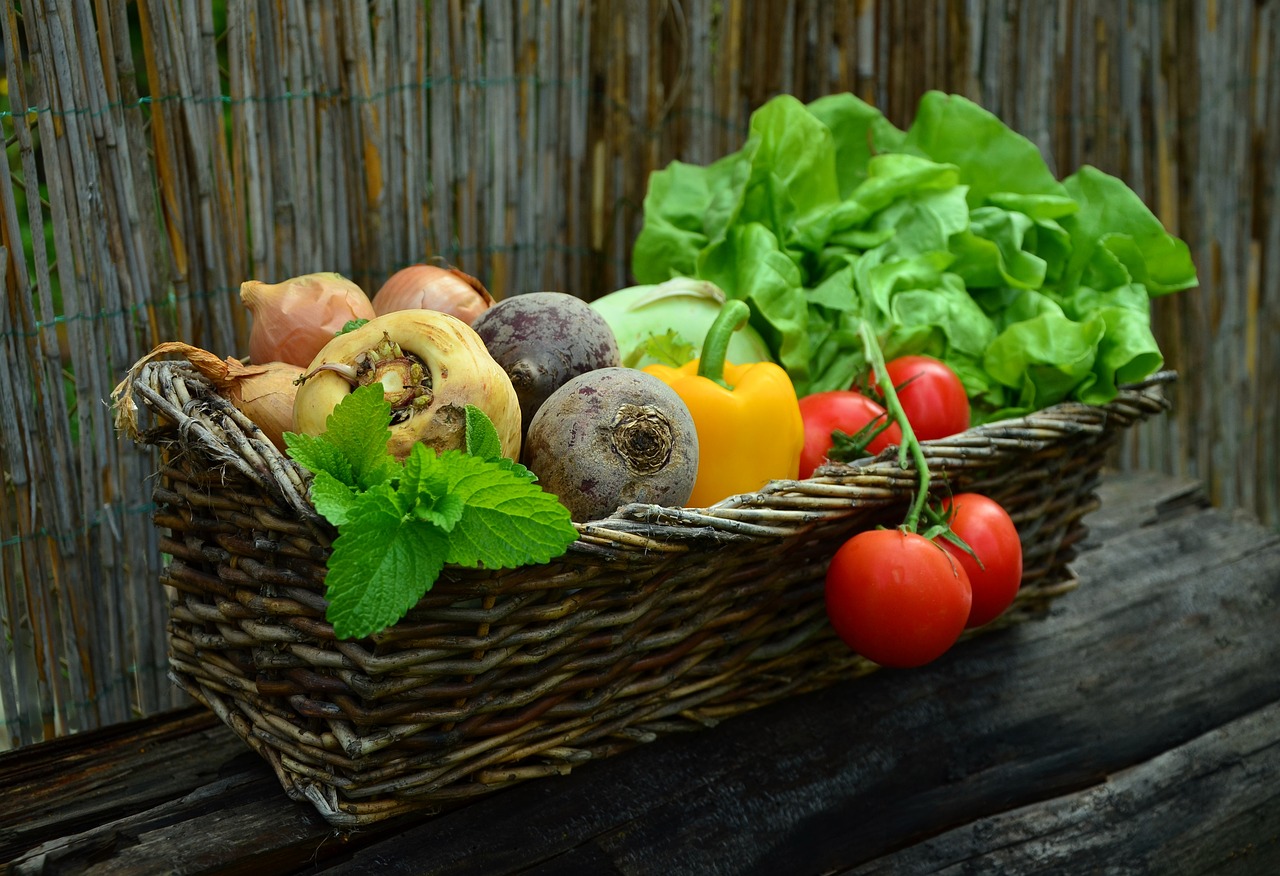Introduction
Asparagus, with its distinct flavor and vibrant green spears, is a prized addition to many gardens and dinner tables. Growing your own asparagus is not only rewarding but also a sustainable way to enjoy this nutritious vegetable. However, asparagus is a perennial crop with specific requirements, so successful cultivation requires careful planning and maintenance. In this article, we will provide you with valuable tips for growing asparagus to ensure a bountiful and delicious harvest.
Cultivating asparagus in your own garden is an endeavor that promises both culinary delight and sustainability. The unique flavor and vibrant green spears of asparagus make it a sought-after addition to home gardens and dinner menus. However, growing asparagus requires more than just planting and waiting; it demands a thoughtful and dedicated approach to ensure a thriving crop. Here, we delve into the art of asparagus cultivation, offering you a treasure trove of tips and insights to ensure a fruitful and flavorsome harvest.
Long-Term Investment: It’s essential to understand that asparagus is a perennial crop, meaning it will return year after year with the proper care. This long-term commitment requires patience, but the rewards are well worth it, as a well-established asparagus bed can produce abundant harvests for up to two decades.
Site Selection: The success of your asparagus bed begins with choosing the right location. Asparagus thrives in well-drained, sunny spots with good air circulation. Select an area where the soil is fertile, with a pH level between 6.0 and 7.0, and free from perennial weeds.
Preparation and Planting: Prepare the soil by incorporating organic matter to improve fertility and drainage. Asparagus is typically grown from crowns or seeds. Plant crowns in trenches, spacing them at least 12-18 inches apart in rows separated by 3-4 feet. Water the newly planted crowns thoroughly to encourage root development.
Patient Waiting: The first year after planting, restrain yourself from harvesting any asparagus spears. Allow the plants to establish strong root systems and store energy. In the second year, lightly harvest for two weeks or so, and gradually extend the harvesting period as the plants become more robust.
Mulching and Weed Control: Mulching is your ally in asparagus cultivation. Apply a layer of mulch to conserve soil moisture, suppress weeds, and maintain even soil temperatures. Regularly weed the asparagus bed to prevent unwanted competition for nutrients.
Feeding for Growth: Asparagus is a nutrient-hungry plant, so periodic fertilization is crucial. Apply a balanced, all-purpose fertilizer according to the recommended rates. Keep in mind that asparagus plants benefit from a steady supply of nutrients throughout the growing season.
Pest and Disease Management: Monitor your asparagus bed for common pests like aphids and asparagus beetles. Early detection and prompt action can prevent infestations. Additionally, maintain good garden hygiene to minimize the risk of diseases.
Overwintering and Pruning: In late fall, cut back the fern-like foliage to ground level after it turns yellow. This helps prevent disease and makes way for new growth in the following spring.
Harvesting Techniques: Harvest asparagus spears when they reach 6-8 inches in length and are about the thickness of your pinky finger. Use a sharp knife or scissors to cut them at ground level. Regular harvesting encourages the production of more spears.
Enjoy the Bounty: With patience and care, your asparagus bed will reward you with a bountiful harvest. Whether you enjoy your asparagus grilled, roasted, steamed, or in salads, there’s no denying the satisfaction of savoring homegrown, tender spears.
By following these expert tips for growing asparagus, you embark on a journey of sustainable and delectable gardening. Your dedication will result in an enduring source of this nutritious and flavorful vegetable for years to come, making your garden and dinner table all the more delightful.
Additionally, you can find further information on this topic by visiting this page: How to Grow Asparagus Like a Pro | Gardener’s Path
Selecting the ideal location is the first step in growing asparagus successfully. Asparagus plants are long-lived and can produce for up to 20 years, so it’s crucial to choose a spot where they can thrive. Here’s what to consider:
When embarking on the journey of growing asparagus, the importance of selecting the perfect location cannot be overstated. Asparagus plants are not your typical short-term crop; they are long-lived and possess the potential to produce delectable spears for up to two decades. Therefore, the decision regarding their planting spot is a pivotal one, as it will significantly impact their growth and productivity. Here are some key considerations to keep in mind:
Sunlight Exposure: Asparagus plants are sun-worshippers. To thrive, they require full sun exposure, which generally means at least 6-8 hours of direct sunlight per day. Choosing a location with ample sunlight ensures vigorous growth and bountiful harvests.
Soil Quality: Asparagus has a reputation for being somewhat finicky about its soil. It thrives in well-drained, nutrient-rich soil with a slightly acidic to neutral pH. Conducting a soil test can help you determine the pH level and nutrient content of your chosen spot. Amending the soil with organic matter can improve its quality and fertility.
Drainage: Adequate drainage is critical to prevent waterlogged roots, which can lead to rot and other problems. Select a location with good natural drainage, or consider raised beds if your soil tends to hold water.
Space: Asparagus plants spread out as they grow, so spacing is crucial. Plant them at least 18 inches apart in rows, with 4-5 feet between rows. Ensure there’s ample room for the mature plants to expand without crowding.
Weed and Pest Control: Asparagus is vulnerable to weed competition and certain pests. Choose a location where you can easily manage weeds and implement pest control measures as needed.
Long-Term Commitment: Keep in mind that asparagus plants are a long-term investment. They typically take a few years to reach full production, but once established, they can continue to produce for many years. Be prepared for a commitment that extends over a decade or more.
Climate Considerations: Consider your local climate and its suitability for asparagus cultivation. Asparagus has different varieties adapted to different temperature ranges. Ensure you’re selecting varieties that are well-suited to your region.
By carefully considering these factors when choosing the location for your asparagus bed, you set the stage for a successful and rewarding asparagus-growing experience. With the right spot, these hardy and delicious plants can provide you with a bountiful harvest season after season.
For a comprehensive look at this subject, we invite you to read more on this dedicated page: Growing Asparagus in Missouri | MU Extension

Asparagus loves sunlight, so choose a location that receives at least 6-8 hours of direct sunlight each day.
Asparagus, the sun-loving champion of the vegetable garden, thrives when bathed in ample sunlight. Here’s why selecting a location that receives a generous dose of 6-8 hours of direct sunlight each day is essential for cultivating robust asparagus plants and ensuring a bountiful harvest:
Optimal Photosynthesis: Asparagus relies on photosynthesis, a fundamental process where plants convert sunlight into energy. Adequate sunlight exposure fuels this process, allowing asparagus to produce the sugars and starches it needs to grow and store energy in its roots for future growth.
Vigorous Shoot Development: Asparagus is renowned for its tender, succulent shoots that are harvested and enjoyed. Abundant sunlight promotes the development of these shoots, encouraging them to grow straight, firm, and full of flavor. Inadequate sunlight can result in weak, spindly shoots that are less desirable for consumption.
Enhanced Yield: Sunlight is directly linked to the productivity of asparagus plants. A well-lit asparagus bed yields more and larger spears, providing you with a more substantial harvest. With the right amount of sunlight, you can enjoy a more bountiful supply of fresh asparagus during the growing season.
Reduced Disease Risk: Sunlight plays a crucial role in reducing the risk of fungal diseases that can afflict asparagus. Ample sunlight exposure helps to dry the soil’s surface and foliage, making it less hospitable to mold and mildew, common culprits in asparagus ailments.
Stronger, Healthier Roots: Asparagus plants store energy in their root systems, known as crowns. This energy reserve fuels the next year’s growth. Sunlight allows for efficient photosynthesis, leading to robust and energy-rich crowns that ensure the longevity and vitality of your asparagus patch.
Earlier Harvest: With sufficient sunlight, asparagus spears emerge earlier in the growing season. This not only means an earlier harvest but also extends the duration of the harvest season, providing you with fresh asparagus for a more extended period.
Optimal Taste and Nutritional Value: Sunlight enhances the flavor and nutritional value of asparagus. The sugars produced through photosynthesis contribute to the sweet, earthy taste of well-grown asparagus, making it a more delightful addition to your meals.
Resilience to Pests: Well-exposed asparagus plants are more resistant to certain pests. Sunlight helps to deter aphids and other insects that can damage asparagus crops.
Sustainable Growth: Maximizing sunlight allows asparagus plants to thrive naturally, reducing the need for excessive fertilizers and pesticides. This aligns with sustainable and eco-friendly gardening practices.
In sum, choosing a sunny location for your asparagus bed is a fundamental step in ensuring a successful and rewarding harvest. With ample sunlight, your asparagus plants will flourish, producing tender, delicious spears that can be enjoyed throughout the growing season. So, bask your asparagus in the sun’s embrace, and watch as it transforms into a sun-kissed delight in your garden.
Don’t stop here; you can continue your exploration by following this link for more details: 30+ Vegetables That Grow in Shade
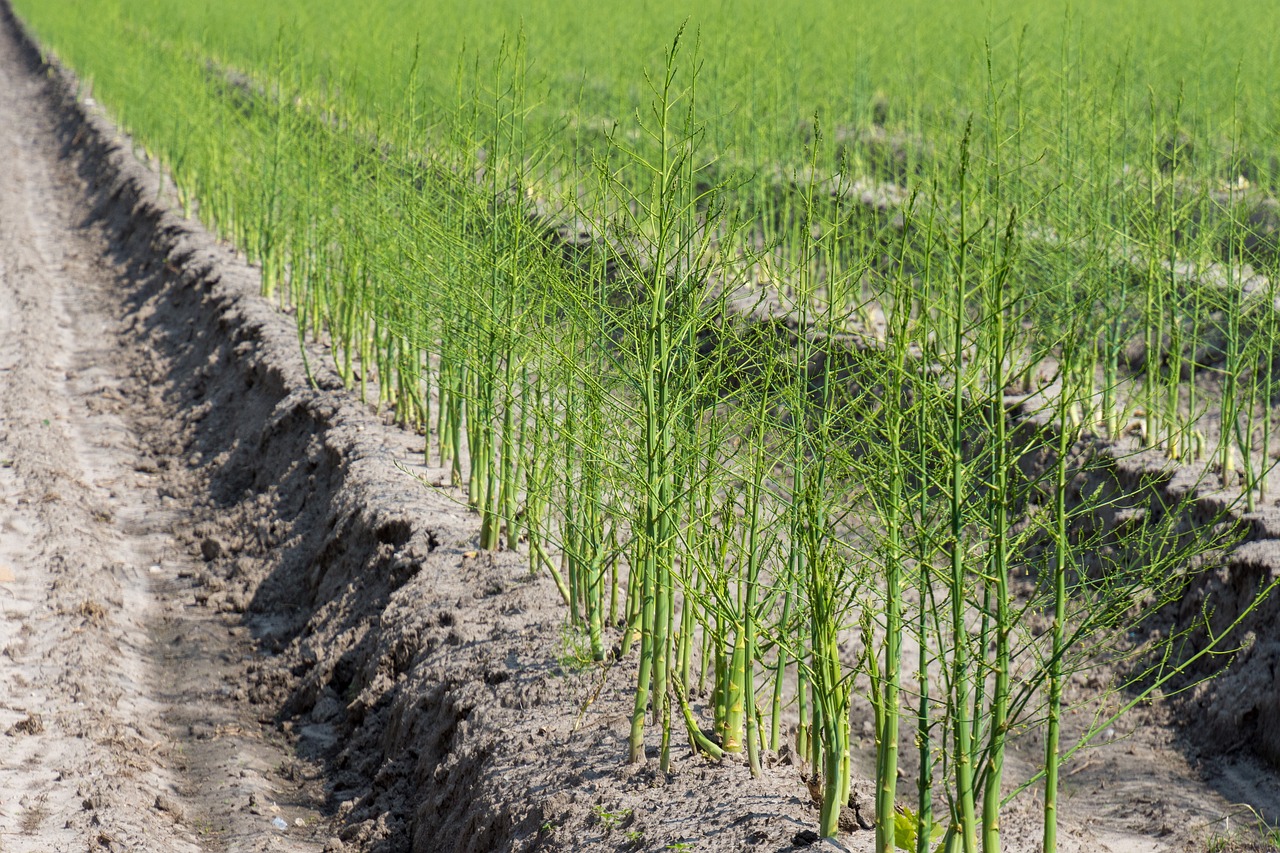
Asparagus prefers well-drained, sandy or loamy soil that is rich in organic matter. Avoid areas prone to waterlogging, as this can lead to root rot.
Cultivating asparagus successfully begins with understanding its finicky soil preferences. This vibrant and nutritious vegetable thrives in well-drained, sandy or loamy soil that is generously enriched with organic matter. The choice of soil isn’t just a matter of convenience; it can significantly influence the health and yield of your asparagus crop.
Well-Drained Soil: Asparagus has little tolerance for waterlogged conditions. Planting it in well-drained soil is paramount because waterlogged roots can lead to a host of problems, the most notorious being root rot. In waterlogged conditions, the roots suffocate, which can ultimately stunt the growth of the plant and even lead to its demise. To ensure your asparagus thrives, pick a site where water drains freely, preventing excess moisture from pooling around the roots.
Sandy or Loamy Soil: Asparagus exhibits a preference for sandy or loamy soil due to its excellent drainage capabilities. These soil types allow excess water to percolate through quickly, reducing the risk of waterlogged roots. Additionally, sandy and loamy soils are known for their loose texture, which facilitates root development and makes it easier for young asparagus shoots to emerge from the ground.
Rich in Organic Matter: Asparagus, like most vegetables, benefits from soil that’s rich in organic matter. Organic matter not only enhances soil structure but also provides essential nutrients as it decomposes. Amending your soil with compost or well-rotted manure helps asparagus plants access the nutrients they need for robust growth and bountiful harvests.
The Role of pH: While not as picky as some other crops, asparagus prefers slightly acidic to neutral soil with a pH range of 6.5 to 7.5. Maintaining the right pH level in your soil ensures that the plant can efficiently absorb nutrients from the soil, promoting healthy growth.
Understanding the specific soil requirements of asparagus is crucial for setting the stage for a successful harvest. By providing well-drained, sandy or loamy soil enriched with organic matter and maintaining the appropriate pH level, you not only prevent root rot but also create the optimal conditions for asparagus to flourish. This attention to soil health is an investment that pays off in the form of lush, thriving asparagus plants and an abundant harvest for years to come.
Explore this link for a more extensive examination of the topic: Asparagus | NC State Extension Publications
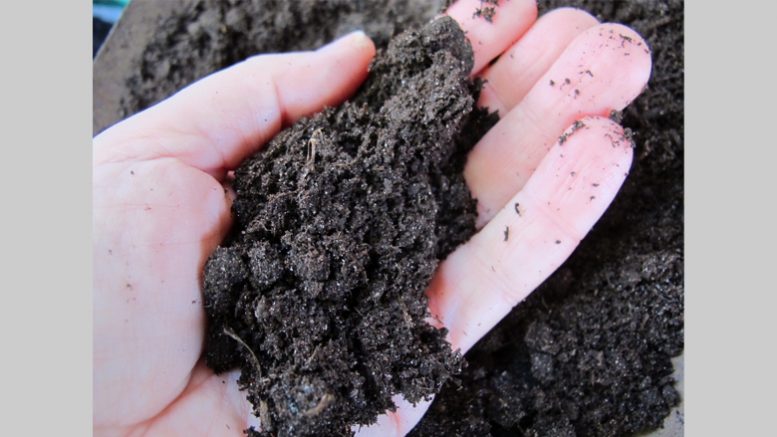
Conduct a soil test to determine its pH level. Asparagus prefers slightly acidic to neutral soil with a pH range of 6.5 to 7.5. Adjust the pH if necessary.
Conducting a soil test to assess its pH level is a foundational step in creating the ideal environment for asparagus growth. Asparagus, with its distinct requirements, thrives best in soil that falls within the slightly acidic to neutral pH range of 6.5 to 7.5. This pH range ensures that the asparagus plants can efficiently access essential nutrients from the soil, setting the stage for robust growth and bountiful harvests.
But what if your soil’s pH doesn’t align with this preferred range? Here’s where the art of soil management comes into play:
1. pH Adjustment: If your soil pH falls outside the 6.5 to 7.5 range, it’s important to adjust it to create the optimal conditions for asparagus cultivation. If your soil is too acidic (below 6.5), you can raise the pH by adding lime, typically in the form of ground limestone. Conversely, if your soil is too alkaline (above 7.5), you can lower the pH by incorporating organic matter like compost or well-rotted manure. Regular testing and adjustments help fine-tune the soil to meet the precise needs of asparagus.
2. Proper Nutrient Uptake: Maintaining the correct pH range not only ensures that the soil chemistry aligns with asparagus preferences but also influences nutrient availability. At the right pH, essential nutrients like phosphorus, potassium, and trace elements become more accessible to the plants, promoting healthy growth and development. This means your asparagus will be better equipped to resist diseases, produce strong spears, and establish a vigorous root system.
3. Preventing Nutrient Imbalances: Beyond facilitating nutrient uptake, maintaining the correct pH range also helps prevent nutrient imbalances. When soil pH is too high or too low, it can lead to nutrient deficiencies or toxicities, which can stunt growth and reduce yields. Adjusting the pH helps prevent these issues, ensuring that your asparagus plants receive the precise nutrients they need in the right proportions.
4. Sustainable Growth: Optimal soil pH not only benefits your asparagus but also contributes to sustainable farming practices. By providing the right conditions for your crop without overreliance on synthetic fertilizers, you promote environmentally friendly agriculture and reduce the risk of nutrient runoff, which can harm nearby water bodies.
In conclusion, soil testing and pH adjustment are essential steps in preparing your asparagus bed for successful cultivation. This proactive approach ensures that your asparagus plants receive the right balance of nutrients, fostering their health, resilience, and productivity. By nurturing the soil in this way, you lay the foundation for a bountiful asparagus harvest and sustainable agricultural practices.
Explore this link for a more extensive examination of the topic: Growing asparagus in home gardens | UMN Extension
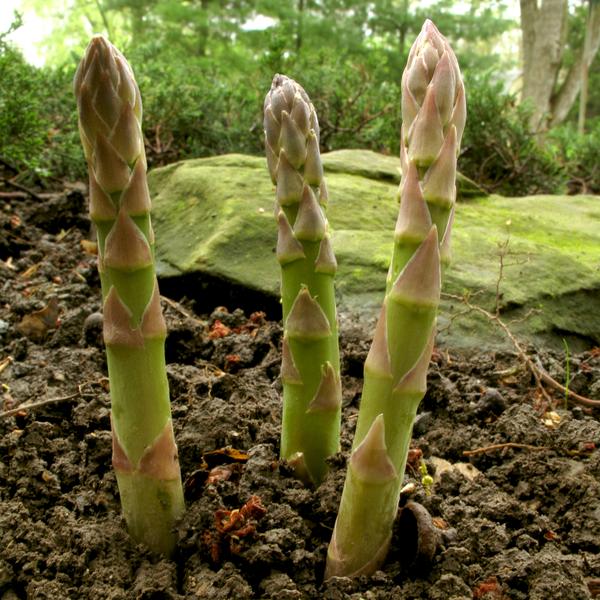
Incorporate plenty of well-rotted compost or aged manure into the soil. Asparagus benefits from fertile, nutrient-rich soil.
Ensuring your asparagus thrives begins with the foundation it grows in. By incorporating ample well-rotted compost or aged manure into the soil, you provide this perennial vegetable with the essential nutrients it craves. This practice not only enriches the soil but also sets the stage for a bountiful and healthy asparagus harvest. Here’s why this step is crucial:
Nutrient-Rich Soil: Asparagus is a nutrient-hungry plant, particularly during its initial stages of growth. Well-rotted compost or aged manure is a treasure trove of essential nutrients. By blending these organic amendments into the soil, you create a fertile environment that supplies the asparagus with a steady stream of vital elements, promoting robust growth and development.
Improved Soil Structure: Organic matter, such as compost or aged manure, enhances soil structure. It improves aeration, water-holding capacity, and drainage, creating an environment that supports healthy root development. This allows the asparagus roots to penetrate deep into the soil, anchoring the plant securely and accessing nutrients effectively.
Microbial Activity: Organic matter
Don’t stop here; you can continue your exploration by following this link for more details: How to Grow Asparagus in Your Garden | USU

Asparagus comes in both male and female varieties, with male plants generally being preferred for their higher yield and lack of seed production. Common male cultivars include ‘Jersey Giant’ and ‘Jersey Knight,’ while ‘Mary Washington’ is a popular female variety.
The choice between male and female asparagus plants in your garden can significantly impact your overall harvest and maintenance efforts. Here’s a more in-depth look at the differences between these varieties and why male plants are often favored:
Male Asparagus Plants:
Higher Yield: Male asparagus plants generally produce a higher yield of edible spears compared to their female counterparts. Since they don’t allocate energy to seed production, they channel more nutrients into producing spears, making them a more efficient choice for those seeking a generous asparagus harvest.
Lack of Seed Production: Perhaps the most significant advantage of male plants is their lack of seed production. Asparagus plants can produce tiny red berries, which contain seeds. While these berries may seem harmless, they can lead to self-seeding and the growth of unwanted asparagus plants in your garden. Male plants eliminate this concern, making maintenance and weed control more straightforward.
Varieties: Common male asparagus cultivars, such as ‘Jersey Giant’ and ‘Jersey Knight,’ are known for their robust growth, large, tender spears, and consistent performance. These varieties are favored by many gardeners for their reliable yields and quality produce.
Female Asparagus Plants:
Seed Production: Female asparagus plants, like ‘Mary Washington,’ are primarily chosen when the goal is to save seeds for propagation or if you plan to grow asparagus from seed. Their berries contain viable seeds that can be harvested and used to start new plants. This can be beneficial if you want to expand your asparagus patch without purchasing additional crowns.
Smaller Harvest: Female plants often yield fewer edible spears compared to male plants because some of their energy goes into seed production. If your primary focus is a bountiful harvest of asparagus spears, male plants are the preferred choice.
In summary, the decision to grow male or female asparagus plants depends on your specific gardening goals. For those seeking a plentiful asparagus harvest with minimal maintenance, male varieties like ‘Jersey Giant’ and ‘Jersey Knight’ are excellent choices. However, if you are interested in seed saving or expanding your asparagus patch from seed, a female variety like ‘Mary Washington’ may be the right fit for your garden. Ultimately, both types can thrive with proper care and provide you with delicious, homegrown asparagus for years to come.
You can also read more about this here: Asparagus: How to Plant, Grow, and Harvest Asparagus | The Old …

Asparagus is typically propagated from crowns, which are the root systems of established plants. Here’s how to plant them:
Asparagus, a beloved addition to many gardens and dining tables, begins its journey as a humble crown—the root system of a mature plant. The process of planting asparagus crowns is not only straightforward but also the key to a bountiful harvest for years to come. Here’s a step-by-step guide on how to plant them:
Choose the Right Location: Select a sunny and well-drained spot in your garden. Asparagus thrives in full sunlight and prefers soil that drains well to prevent root rot.
Prepare the Soil: Asparagus enjoys slightly acidic to neutral soil with a pH level between 6.0 and 7.0. Work the soil to a depth of at least 12 inches, removing any weeds, rocks, or debris.
Dig Trenches: Asparagus is traditionally planted in trenches or furrows. Dig a trench that’s about 12 inches wide and 6-8 inches deep. Space the trenches about 3 feet apart.
Spacing: Within the trench, create mounds of soil at the bottom, spacing them about 18 inches apart. These mounds will serve as the planting sites for your crowns.
Soak Crowns: Before planting, soak the asparagus crowns in water for about an hour. This helps rehydrate them and encourages robust growth.
Plant Crowns: Place each crown on top of a soil mound, spreading the roots out gently. Position them so that they are about 1-2 inches below the soil’s surface.
Cover with Soil: Carefully cover the crowns with 2 inches of soil. As the asparagus grows, you’ll gradually fill in the trench with more soil until it’s level with the ground.
Water Thoroughly: After planting, water the asparagus crowns thoroughly to settle the soil and ensure good root-to-soil contact.
Mulch and Maintain: Apply a layer of mulch to help retain moisture, suppress weeds, and regulate soil temperature. Keep the area weed-free, and water consistently to keep the soil evenly moist.
Patience and Harvest: Asparagus takes some time to establish itself. It’s recommended not to harvest any spears during the first year to allow the plant to strengthen. In the second year, you can start harvesting, but be gentle to avoid damaging the young plants. As the plants mature, you’ll enjoy a bountiful harvest for years to come.
Remember that asparagus is a perennial crop, and with proper care and maintenance, your asparagus bed can produce delicious spears for up to 15 years or more. So, take your time during the planting process, and you’ll be rewarded with an enduring source of fresh, homegrown asparagus.
For additional details, consider exploring the related content available here With the right care, asparagus beds will produce for decades …

Dig trenches that are about 8-10 inches deep and 12-18 inches wide. Space the trenches about 4-5 feet apart.
When it comes to creating trenches for various purposes, such as gardening or drainage, specific dimensions and spacing play a crucial role in achieving your desired outcomes effectively. Here’s a closer look at the significance of digging trenches that are approximately 8-10 inches deep and 12-18 inches wide, with a recommended spacing of about 4-5 feet apart:
Optimal Planting Depth: For gardening and agriculture, the depth of the trench is a critical consideration. A depth of 8-10 inches is generally well-suited for many types of plants, including vegetables and flowers. This depth provides ample space for root development and access to nutrients and moisture in the soil. It also allows for proper anchoring of the plants, which is especially important for tall or top-heavy varieties.
Adequate Root Space: The width of the trench, spanning 12-18 inches, is equally important. It provides adequate room for plant roots to spread and grow. Wide trenches allow for a more extensive root system, which can enhance nutrient absorption and overall plant health. Additionally, the spacing between trenches helps prevent overcrowding, ensuring that plants receive sufficient access to sunlight, water, and nutrients.
Efficient Drainage: Trenches are often used for drainage purposes, especially in areas prone to waterlogging or heavy rainfall. The recommended dimensions and spacing help create efficient drainage channels. A wider trench can accommodate a greater volume of water, preventing excess moisture from accumulating around plant roots and causing root rot or other water-related issues.
Ease of Maintenance: Practical considerations come into play when determining trench dimensions and spacing. A width of 12-18 inches allows for convenient weeding, maintenance, and harvesting. It also provides ample space for adding compost or organic matter to enrich the soil as needed.
Uniformity and Aesthetics: Spacing trenches at 4-5 feet apart ensures a degree of uniformity in your garden layout. This not only makes maintenance more straightforward but also contributes to an aesthetically pleasing garden design. Proper spacing can also facilitate the use of gardening equipment, such as wheelbarrows or garden carts, between the trenches.
In summary, the dimensions and spacing of trenches in gardening, agriculture, or drainage projects are not arbitrary; they are carefully chosen to optimize plant growth, ensure efficient drainage, simplify maintenance, and enhance the overall functionality and appearance of the area. By adhering to these recommended dimensions and spacing guidelines, you can create a well-organized, productive, and visually appealing space for your specific needs.
Additionally, you can find further information on this topic by visiting this page: How to successfully grow asparagus in your garden | Illinois …

Place the asparagus crowns at the bottom of the trench, spacing them about 12-18 inches apart.
“When it comes to planting asparagus, proper placement in the trench is a key step in ensuring a bountiful harvest. As you embark on this gardening journey, consider the following guidelines for positioning the asparagus crowns at the bottom of the trench, maintaining a spacing of approximately 12-18 inches between each.
Optimal Crowns Placement: Placing the asparagus crowns snugly at the trench’s base is crucial for their development. Ensure that the crowns’ roots are well-spread and gently tucked into the soil. This careful placement allows the crowns to establish strong root systems, which are essential for their long-term growth and productivity.
Spacing for Healthy Growth: The 12-18 inch spacing is not arbitrary; it’s rooted in the need for asparagus plants to have ample room to flourish. This spacing provides each plant with sufficient access to nutrients and reduces competition for resources, promoting robust and healthy growth.
Adequate Air Circulation: Proper spacing also encourages adequate air circulation between the plants. Good air circulation is essential for preventing the development of fungal diseases and ensuring the overall health of the asparagus bed. Adequate spacing helps minimize humidity around the plants, reducing the risk of moisture-related issues.
Ease of Harvesting: The spacing between asparagus crowns also impacts ease of harvesting. With the recommended 12-18 inch gap, you’ll find it more convenient to access individual spears without damaging adjacent plants. This facilitates regular harvesting and ensures a longer harvesting season.
Room for Expansion: Asparagus is a perennial plant, and it will continue to produce for many years. Proper spacing allows room for the crowns to expand and produce more spears as they mature. Crowded plants can become intertwined, making it challenging to separate the spears during harvesting.
Sunlight Access: Adequate spacing ensures that each asparagus plant receives its fair share of sunlight. This is crucial for photosynthesis, which fuels the growth and development of the spears and the subsequent replenishment of energy stores in the crowns for the following season.
Overall Garden Aesthetics: Proper spacing not only benefits the plants but also contributes to the overall aesthetics of your garden. Neatly spaced asparagus rows create an organized and visually pleasing appearance, making your garden both productive and beautiful.
In conclusion, the precise placement and spacing of asparagus crowns at the bottom of the trench are essential steps for a thriving asparagus bed. This careful attention to detail ensures healthy growth, ease of harvesting, disease prevention, and the long-term success of your asparagus patch. By adhering to these guidelines, you set the stage for years of abundant asparagus harvests to come.”
To delve further into this matter, we encourage you to check out the additional resources provided here: With the right care, asparagus beds will produce for decades …

Cover the crowns with 2 inches of soil initially. Gradually fill in the trench as the asparagus grows throughout the season.
When it comes to nurturing your asparagus crop, proper planting and ongoing care are crucial for a bountiful harvest. After placing the crowns in the trench and covering them with an initial 2 inches of soil, your job is far from done. As the asparagus plants begin to sprout and thrive throughout the growing season, it’s essential to continue adding soil incrementally to the trench.
This gradual filling-in process serves several essential purposes. Firstly, it provides crucial support to the growing asparagus plants. The additional soil helps anchor the crowns and developing spears, preventing them from toppling over in the wind or under the weight of their foliage. This support is particularly crucial for younger asparagus plants that might not have developed a robust root system yet.
Secondly, this gradual hill-up method helps regulate soil temperature and moisture levels around the asparagus crowns. It acts as a form of insulation, protecting the plants from extreme temperature fluctuations and maintaining a more consistent environment. This stability is especially beneficial for asparagus, which is sensitive to temperature changes and soil moisture.
Furthermore, the gradual filling-in of the trench helps control weed growth around the asparagus bed. By continually adding soil, you bury potential weed seeds, reducing competition for nutrients, water, and sunlight. This promotes healthier asparagus growth and minimizes the need for labor-intensive weeding.
Lastly, the hill-up process encourages the development of longer, more desirable asparagus spears. As you add soil and the plants continue to grow, the spears emerge from deeper within the soil, resulting in longer, more tender shoots. These are the delicious spears you’ll eagerly anticipate harvesting.
So, remember, nurturing your asparagus bed is an ongoing process. Gradually filling in the trench as the asparagus grows is not just about physical support but also about creating the optimal conditions for a robust, productive crop. It’s a commitment that pays off with each succulent bite of homegrown asparagus.
Don’t stop here; you can continue your exploration by following this link for more details: Growing asparagus in home gardens | UMN Extension

Asparagus is not a crop for the impatient gardener. It takes a couple of years for asparagus to establish a strong root system and become productive. During the first year, avoid harvesting any spears to allow the plant to channel its energy into root development.
Growing asparagus is a lesson in patience and long-term planning, but the rewards are well worth the wait. Here’s a more detailed exploration of the cultivation process for asparagus, emphasizing the importance of nurturing its root system during the initial stages:
Establishing Strong Roots: Asparagus, with its deep and extensive root system, is an investment in the future. During the first year of growth, it focuses its energy on developing these robust roots, which are crucial for nutrient uptake and overall plant health. This phase is foundational to the plant’s long-term productivity.
Year One: The Wait Begins: In the initial year after planting, it’s essential to resist the temptation to harvest any spears. Instead, concentrate on providing the plant with optimal growing conditions. This means ensuring it receives adequate sunlight, water, and nutrients to support vigorous root development.
Mulching and Weed Control: Apply a layer of mulch around the asparagus bed to conserve moisture, suppress weed growth, and maintain a more stable soil temperature. This helps reduce competition for resources, allowing the asparagus to thrive.
Feeding for Success: Asparagus benefits from well-balanced soil enriched with organic matter. Incorporate compost or well-rotted manure into the soil to provide essential nutrients and maintain soil fertility. Fertilize as needed, following recommended guidelines to prevent over-fertilization, which can harm the plant.
Year Two and Beyond: In the second year, your patience begins to pay off. You can start harvesting asparagus spears, but exercise restraint. Only harvest a few spears from each plant to allow the majority of the energy to continue fueling root growth. This cautious approach ensures that your asparagus bed becomes even more productive in the years ahead.
Harvesting Techniques: When harvesting asparagus, use a sharp knife or asparagus harvesting tool to cut the spears just below the soil surface. Avoid snapping them, as this can damage the crown. Harvest when the spears are approximately 6-8 inches tall for the best tenderness and flavor.
Year After Year Yield: With each passing season, your asparagus bed will become increasingly productive. Asparagus plants can produce spears for 15 years or more when properly cared for. This long-term yield makes the initial waiting period worthwhile.
Crop Rotation: To prevent soilborne diseases and pests, practice crop rotation. Avoid planting asparagus in the same location for extended periods. Instead, rotate it with other crops in your garden.
Pest and Disease Management: Keep an eye out for common asparagus pests like asparagus beetles and aphids. Implement pest control measures as needed to protect the health of your plants.
Enjoy the Harvest: As the years go by, you’ll have a bountiful supply of fresh, homegrown asparagus to enjoy. From springtime soups and salads to roasted or grilled side dishes, the culinary possibilities are endless.
In conclusion, growing asparagus is a lesson in delayed gratification, but the eventual rewards are well worth the initial patience and care. By focusing on root development during the first year and practicing sound cultivation techniques, you can ensure a productive and delicious asparagus patch that continues to yield for many years to come.
If you’d like to dive deeper into this subject, there’s more to discover on this page: With the right care, asparagus beds will produce for decades …
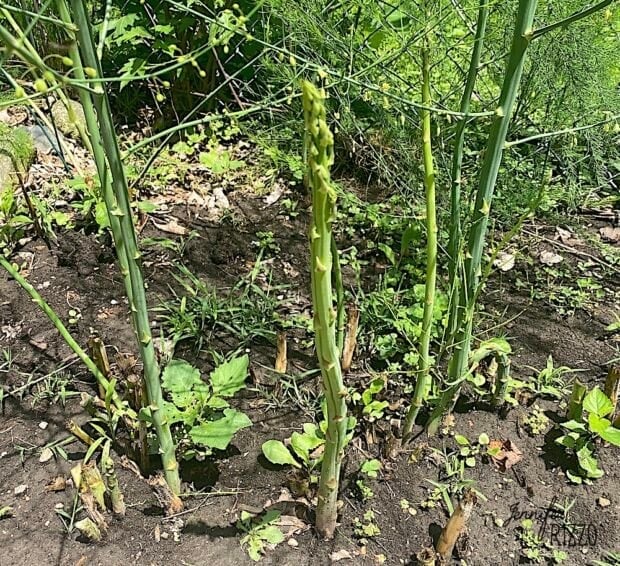
Mulching around the asparagus bed helps retain moisture, suppress weeds, and regulate soil temperature. Apply a layer of organic mulch, such as straw or wood chips, in the spring.
Mulching is a time-tested practice in gardening that offers a plethora of benefits, and when it comes to asparagus cultivation, it’s a game-changer. Here’s a deeper look at why mulching around your asparagus bed is a vital component of successful cultivation and how it contributes to the health and productivity of your asparagus crop:
Moisture Retention: Asparagus, like many plants, has a strong need for consistent moisture, especially during its growing season. By applying a layer of organic mulch, you create a protective barrier over the soil. This barrier reduces moisture loss through evaporation, ensuring that the soil remains consistently damp. Inconsistent soil moisture can lead to stress for asparagus plants and result in thinner spears and reduced yields. Mulching, therefore, helps maintain the necessary moisture levels for optimal growth and spear development.
Weed Suppression: Weeds are the persistent adversaries of any garden, competing with your prized plants for nutrients and space. When you mulch around your asparagus bed, you create a natural defense against these unwelcome intruders. The mulch acts as a physical barrier, preventing weed seeds from making direct contact with the soil and germinating. Fewer weeds mean less competition for resources, allowing your asparagus plants to thrive without unnecessary stress.
Soil Temperature Regulation: Asparagus plants are sensitive to temperature fluctuations, and extreme heat or cold can negatively impact their growth. Organic mulch serves as an insulating layer, helping to regulate soil temperatures. In the scorching heat of summer, it prevents the soil from overheating, reducing stress on the asparagus roots. In the chilly depths of winter, it provides some protection against freezing, helping the crowns survive until spring.
Organic Matter Enrichment: Over time, organic mulch breaks down and contributes valuable organic matter to the soil. As it decomposes, it releases essential nutrients that benefit your asparagus plants. This gradual enrichment of the soil ensures that your asparagus bed remains fertile and capable of supporting healthy growth season after season.
Erosion Control: For gardens situated on slopes or inclines, mulch plays a crucial role in preventing soil erosion. It helps anchor the soil in place, preventing it from washing away during heavy rains or strong winds. This ensures that the delicate root systems of your asparagus plants remain undisturbed, providing a stable foundation for growth.
Improved Aesthetic: While not directly related to plant health, the aesthetic improvement mulch offers should not be overlooked. A well-mulched asparagus bed looks neat and well-maintained. It can transform your garden into an attractive and inviting space, making the asparagus bed a visual centerpiece.
Ease of Maintenance: Lastly, mulching simplifies garden maintenance by reducing the need for constant weeding and watering. With fewer weeds to contend with and soil moisture levels consistently regulated, you can spend less time on maintenance tasks and more time enjoying the fruits (or in this case, spears) of your labor.
In conclusion, mulching is an indispensable ally in your quest for a thriving asparagus bed. It creates an environment conducive to healthy growth by retaining moisture, suppressing weeds, regulating soil temperature, and enriching the soil with organic matter. As you apply a layer of organic mulch in the spring, you’re not just nurturing your asparagus; you’re also ensuring a more productive, low-maintenance, and visually appealing garden space.
Don’t stop here; you can continue your exploration by following this link for more details: Growing asparagus in home gardens | UMN Extension
Asparagus benefits from regular fertilization. Apply a balanced, all-purpose fertilizer in the early spring before spears emerge, and again after the harvest season.
Fertilizing asparagus is a key practice in ensuring healthy growth and a consistent harvest of delectable spears. The timing and type of fertilizer you use can significantly impact the productivity of your asparagus bed.
Early Spring Feeding: The first round of fertilization should occur in early spring, just before the asparagus spears begin to emerge from the ground. At this stage, the plants are waking up from their winter dormancy and require a boost of nutrients to support vigorous growth. Applying a balanced, all-purpose fertilizer rich in nitrogen helps kickstart this growth phase. Nitrogen is crucial for the development of strong, leafy foliage, which in turn aids in the production of energy for the plant.
Post-Harvest Fertilization: After the asparagus harvest season has concluded, typically in late spring or early summer, it’s time for the second round of fertilization. This post-harvest feeding is essential for replenishing the nutrients that the plants expended during the growth and spearing season. A balanced fertilizer, or one slightly higher in phosphorus and potassium, is ideal for this phase. These nutrients support root development, overall plant health, and the storage of energy for the next growing season.
Avoid Over-Fertilization: While it’s crucial to provide adequate nutrients, it’s equally important not to over-fertilize. Excessive nitrogen, in particular, can lead to problems such as overly lush foliage at the expense of spear production and increased susceptibility to disease. Always follow recommended application rates and guidelines for your chosen fertilizer.
Organic Options: For those who prefer organic gardening methods, there are organic fertilizers available that can provide the necessary nutrients to asparagus plants. Compost and well-rotted manure are excellent organic choices that not only provide nutrients but also improve soil structure and microbial activity.
Soil Testing: To fine-tune your fertilizer application, consider conducting a soil test. Soil testing can help you determine the specific nutrient needs of your asparagus bed and guide your choice of fertilizers.
Mulching: Applying a layer of organic mulch, such as straw or compost, around your asparagus plants can help retain soil moisture and reduce weed competition. As the mulch breaks down, it also contributes valuable nutrients to the soil.
In summary, fertilizing your asparagus plants at the right times with the appropriate nutrients is an essential aspect of successful asparagus cultivation. By following these guidelines and monitoring your plants’ health, you can enjoy a consistent and abundant harvest of tender, flavorful asparagus spears year after year.
If you’d like to dive deeper into this subject, there’s more to discover on this page: How and when to fertilize asparagus: maximize your crop |

Once your asparagus plants are established (usually in the third year), you can begin harvesting. Snap or cut spears when they are 6-8 inches tall, before the tips start to open up. Harvest for 6-8 weeks in the spring, then allow the remaining spears to grow into fern-like foliage to nourish the roots for the next season.
Harvesting asparagus is a rewarding and strategic endeavor that requires patience and care, but the results are well worth the effort. Here’s a more comprehensive exploration of the idea:
Establishment and Patience: Asparagus is not a crop for the impatient gardener. It typically takes two to three years for asparagus plants to establish a robust root system before they are ready for full-scale harvesting. This initial investment in patience pays off in the long run, as mature asparagus plants can produce for many years.
Ideal Harvesting Height: The ideal harvesting height for asparagus spears is around 6-8 inches. This stage ensures that the spears are at their most tender and flavorful. Harvesting at this height also prevents the spears from becoming tough and fibrous, as they tend to do if left to grow taller.
Timing is Crucial: Timing is everything when it comes to asparagus harvesting. It’s essential to snap or cut the spears just as they reach the desired height and before their tips begin to open up. The moment they start to open, they become less palatable and may develop a woody texture.
Harvest Duration: In the spring, asparagus offers a relatively short but abundant harvest window that typically lasts for 6-8 weeks. During this period, you can enjoy a regular supply of fresh asparagus spears. Be diligent about monitoring your patch during this time, as asparagus can grow quickly.
Selective Harvesting: When harvesting asparagus, it’s crucial to be selective. Only harvest the thicker, more mature spears during the initial stages of the harvest season. Allow the thinner spears to grow into larger ones, as they will become the future harvest for the next season.
Natural Progression to Fern-Like Foliage: After the initial spring harvest, it’s time to switch gears. Allow the remaining asparagus spears to grow undisturbed, eventually transforming into a lush, fern-like foliage. This foliage serves a vital purpose by capturing sunlight and converting it into energy through photosynthesis. This energy is stored in the roots and fuels the growth of the following year’s crop.
Maintenance and Care: While the asparagus ferns grow, continue to provide care to your plants. Ensure they receive adequate water and nutrients to support their growth and energy storage.
Seasonal Pruning: In late fall or early winter, after the fern-like foliage has turned brown, you can prune it back to ground level. This helps prevent the buildup of potential disease and insect issues during the winter months.
Long-Term Harvesting: Properly managed asparagus patches can continue to yield spears for 15 years or more. Consistent harvesting practices, combined with adequate care and maintenance, are essential for sustaining a healthy and productive asparagus bed.
In summary, harvesting asparagus is a skillful blend of timing, patience, and care. By adhering to these guidelines, you can enjoy a plentiful harvest during the spring, nurture your asparagus plants to provide for future seasons, and relish the taste of homegrown, tender asparagus spears for many years to come.
If you’d like to dive deeper into this subject, there’s more to discover on this page: How to successfully grow asparagus in your garden | Illinois …

Asparagus can be susceptible to certain pests and diseases, such as asparagus beetles and rust. Regular inspection and proper garden hygiene, including removing old fern growth in the fall, can help prevent these issues.
Asparagus, with all its delicious potential, does have its share of vulnerabilities when it comes to pests and diseases. Two common adversaries that gardeners must be vigilant against are asparagus beetles and rust. Fortunately, there are practical steps you can take to safeguard your asparagus crop and ensure a healthy harvest.
Asparagus Beetles: These persistent pests, including the common asparagus beetle and the spotted asparagus beetle, are known for their voracious appetite for asparagus foliage. Left unchecked, they can defoliate your plants and weaken them over time. Regular inspection of your asparagus patch is key to early detection. Look out for the distinctive blue-black or orange beetles and their larvae, which are small, dark, and elongated. Handpicking the beetles and larvae or using a garden-friendly insecticide can help keep their populations in check.
Rust: Asparagus rust is a fungal disease that can affect the fern-like foliage of your asparagus plants. It presents as orange-red pustules on the foliage and can weaken the plant if left untreated. To prevent rust, practice proper garden hygiene. Ensure good air circulation by planting asparagus with adequate spacing. Remove any affected foliage promptly, especially during the growing season. Applying a fungicide labeled for rust control can be effective if the disease persists.
Fall Cleanup: A critical component of asparagus care is fall cleanup. After the growing season has ended and the ferns have turned brown, it’s essential to remove the old foliage from the garden bed. This step helps prevent overwintering of asparagus beetle eggs and fungal spores, reducing the likelihood of infestations and diseases in the following growing season.
Companion Planting: Another strategy to deter pests is companion planting. Placing plants like tomatoes or basil near your asparagus can help repel asparagus beetles. The aromatic qualities of these companion plants can confuse and deter the beetles from settling on your asparagus.
Crop Rotation: To further reduce the risk of pest and disease build-up in the soil, practice crop rotation. Avoid planting asparagus in the same location year after year. Instead, rotate your crops to different garden beds to disrupt the life cycles of potential pests and pathogens.
By combining these proactive measures—regular inspection, early pest and disease intervention, proper garden hygiene, companion planting, and crop rotation—you can effectively manage the vulnerabilities that asparagus faces in the garden. These practices will not only protect your asparagus crop but also ensure a bountiful and healthy harvest year after year.
Don’t stop here; you can continue your exploration by following this link for more details: Asparagus pest management | UMN Extension

In colder climates, apply a thick layer of mulch over the asparagus bed in late fall to protect the crowns from freezing temperatures.
Shielding your asparagus bed from the biting cold of winter in colder climates is a crucial practice that can make all the difference in the health and productivity of your asparagus crop. Applying a generous layer of mulch over the bed as the late fall chill sets in is a strategy that not only protects the crowns from freezing temperatures but also offers several additional benefits:
1. Winter Crown Protection: Asparagus crowns, the underground storage structures that produce those delectable spears, are sensitive to extreme cold. When exposed to freezing temperatures, the crowns can sustain damage, potentially compromising the next year’s harvest. The insulating properties of mulch act as a natural blanket, preventing the crowns from freezing and preserving their vitality.
2. Temperature Regulation: Mulch doesn’t just provide protection from the cold; it also helps maintain a more stable soil temperature. In the winter, soil temperature fluctuations can be quite drastic, and these fluctuations can be damaging to asparagus roots. The mulch layer acts as a buffer, keeping the soil temperature within a range that’s more conducive to the plants’ overall health.
3. Weed Suppression: Winter mulching also plays a role in weed control. By covering the asparagus bed with a thick layer of mulch, you create an effective barrier that inhibits weed growth during the dormant season. This means less competition for water, nutrients, and sunlight when your asparagus plants come out of dormancy in the spring.
4. Moisture Retention: Mulch helps the soil retain moisture, which is especially valuable in cold climates where frozen ground can limit water absorption. By retaining moisture, mulch ensures that your asparagus plants have access to the hydration they need to endure the winter months and thrive when spring arrives.
5. Improved Soil Structure: Over time, as the mulch breaks down, it contributes organic matter to the soil, enhancing its structure and fertility. This gradual enrichment benefits the asparagus bed in the long term, promoting healthy root development and overall plant vigor.
When applying mulch, aim for a thickness of around 3 to 4 inches. Common mulch materials include straw, dried leaves, or wood chips. Be sure to mulch after the first hard frost but before the ground freezes completely. While mulching is a relatively simple practice, its impact on the health and productivity of your asparagus bed can be profound, ensuring that you’ll enjoy an abundant harvest of fresh, tender spears when springtime returns.
Should you desire more in-depth information, it’s available for your perusal on this page: Asparagus: How to Plant, Grow, and Harvest Asparagus | The Old …

Conclusion
Growing asparagus requires patience and care, but the rewards are well worth it. With the right location, soil preparation, and maintenance, you can enjoy a bountiful harvest of fresh, homegrown asparagus for years to come. Plus, the taste of tender, homegrown asparagus spears is a culinary delight that’s hard to beat.
Indeed, growing asparagus embodies the art of patience and the science of care, but the rich rewards that spring forth from this endeavor are a testament to the enduring pleasures of home gardening. Here’s why the journey of nurturing asparagus is so gratifying, and why the delectable taste of tender, homegrown asparagus spears is a culinary delight that’s truly unparalleled:
Savoring Seasonal Delicacy: Asparagus is a harbinger of spring, and nothing quite captures the essence of the season like the sight of those first delicate spears emerging from the soil. Growing your own asparagus means you get to savor this seasonal delicacy at its freshest and finest, with a flavor and tenderness that store-bought asparagus can rarely match.
Long-Term Investment: Planting asparagus is akin to making a long-term investment in your garden’s future. While it requires patience in the initial stages, once established, a well-maintained asparagus bed can produce a bountiful harvest for decades. It’s a gift that keeps on giving, year after year, rewarding your efforts with an abundance of delicious spears.
Health Benefits: Homegrown asparagus isn’t just a culinary delight; it’s a nutritional powerhouse. It’s rich in vitamins, minerals, and antioxidants, offering a myriad of health benefits. By cultivating your own asparagus, you can relish its nutritional advantages while knowing precisely how it was grown and what went into its cultivation.
Culinary Creativity: Freshly harvested asparagus invites culinary creativity. From simple yet divine preparations like roasted asparagus with olive oil and sea salt to more elaborate dishes like asparagus risotto or creamy asparagus soup, the possibilities are endless. Homegrown asparagus serves as a canvas for your culinary imagination, allowing you to explore a wide range of flavors and cooking techniques.
Gardening Satisfaction: There’s a profound sense of accomplishment in successfully growing asparagus. It’s a testament to your gardening skills and dedication. Witnessing those first green shoots emerge from the ground and evolve into vibrant, productive plants is a source of immense satisfaction and pride.
Connection to Nature: Nurturing asparagus connects you more deeply to the rhythms of nature. It teaches you patience as you wait for the plants to establish themselves and offers lessons in attentive care throughout the growing season. This connection to the natural world enriches your gardening experience and fosters a greater appreciation for the cycles of life.
Sharing the Bounty: The abundance of homegrown asparagus provides opportunities for sharing the harvest with friends and family. Whether you give away bundles of fresh asparagus or prepare meals to share, it’s a wonderful way to spread the joy of home gardening and the delectable taste of your efforts.
In summary, growing asparagus isn’t just a horticultural pursuit; it’s a journey of patience, care, and culinary delight. The rewards are not limited to a bountiful harvest but extend to the pleasures of savoring the fresh, tender spears and the deep sense of satisfaction that comes from tending to a thriving garden. It’s a journey well worth embarking upon, one that enriches both the palate and the soul.
To delve further into this matter, we encourage you to check out the additional resources provided here: FSMA Final Rule on Produce Safety | FDA
More links
Looking for more insights? You’ll find them right here in our extended coverage: Growing asparagus in home gardens | UMN Extension
